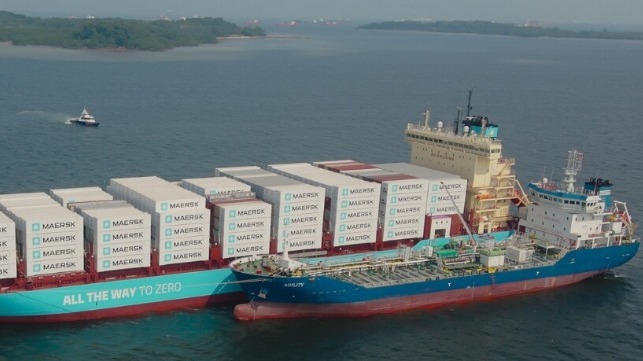Opportunities and Challenges for Transpacific "Green Corridor"

A year after the ports of Singapore, Los Angeles, and Long Beach committed to setting up a green corridor along the Pacific's primary containerized-freight lanes, a new study paints a clear picture of the benefits and challenges ahead for the initiative.
The study, commissioned by global intercity partnership C40 and the three partner ports, and conducted by the American Bureau of Shipping, found that the success of the green and digital shipping corridor (GDSC) initiative rests on the availability, price, and well-to-wake (WtW) emission factors of alternative clean fuels - specifically methanol and ammonia.
Decarbonizing the corridor to meet International Maritime Organization (IMO) net zero targets will see a gradual reduction in demand for fuel oil, while demand for LNG is projected to remain relatively constant from 2025 through to 2050. Most newbuild orders for containerships are for dual-fuel engines, accounting for around 60 percent of the current order book.
The study shows that while methanol and ammonia are expected to play the central role, uncertainties could impact availability of the alternative fuels and limit widespread adoption.
The corridor is currently dominated by the use of conventional fuels. 642 vessels made 1,606 voyages over the period between the first quarter of 2021 and the third quarter of 2023, consuming over 3.9 million tons of oil and resulting in 5.7 million tons of greenhouse gas emissions annually.
A majority of the voyages are indirect in nature, and energy consumed by direct voyages accounted for just 2.5 percent of traffic. About 98 percent of the corridor’s energy demand is currently met with conventional fuels, with much of the remainder being met by LNG. A total of 80 percent of vessel traffic on the corridor is container traffic, 12 percent is petroleum products and six percent is RoRo vessels.
“Both ammonia and methanol-based fuels will be crucial to achieving both short-term targets and long-term deep decarbonization of the shipping activity on the corridor, regardless of the decarbonization trajectory,” notes the study.
Though the path for a green corridor is littered with clean fuel challenges, the corridor has the potential to bring about significant economic benefits for participating countries, green jobs, and health improvements for local communities. No matter the tangible results, the lessons-learned will still be valuable for the industry, according to C40.
“It is important to understand that while a lot of corridors are exploring the feasibility of certain solutions, they may not progress to actually having projects built and ships in the water,” said Alisa Kreynes, Head of Ports and Shipping for C40 Cities, speaking at Singapore Maritime Week. “That doesn’t mean they’re a failure.”
No comments:
Post a Comment